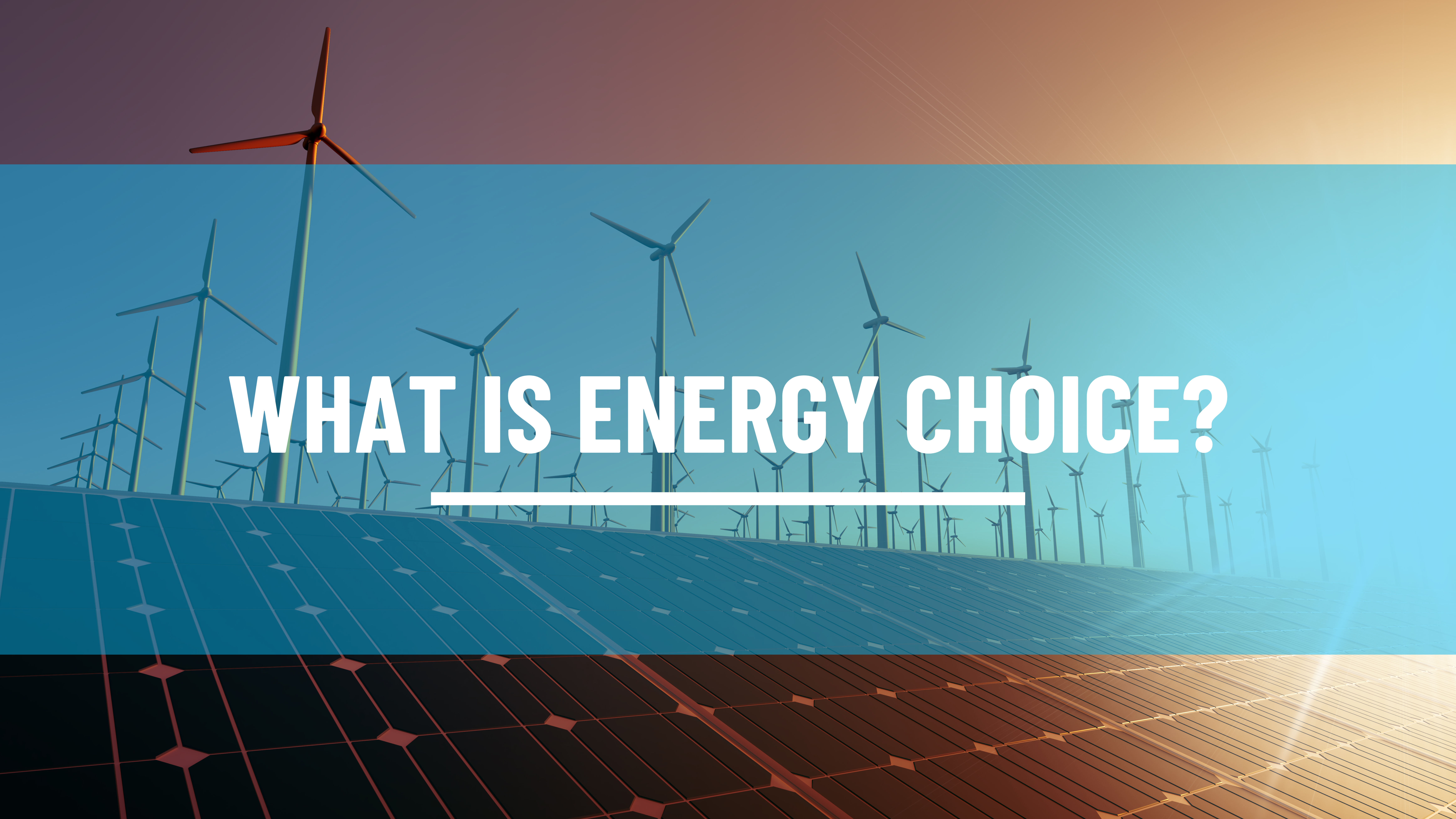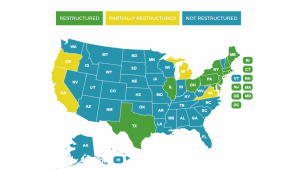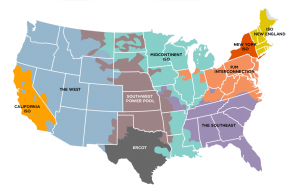
Energy choice is the option available to some customers in the United States to choose their energy provider.
Energy choice empowers consumers to choose their preferred electricity or natural gas supplier with a plan that aligns with their budget, priorities, and values. Suppliers, in turn, focus more on serving the customer and offer a broad variety of products and services. This competition drives innovation in the marketplace and better reflects changing consumer preferences.
For example, a supplier may offer plans with 100% renewable energy options, free electric vehicle (EV) charging on the weekends, or bundled smart home energy services like smart thermostats, smart meters, and backup power options that can improve a home’s energy management.
Retail energy providers offer an alternative to traditional utility services where energy consumers have no choice but to purchase their energy supply from a monopoly utility service provider. These outdated systems fail to keep up with consumer demands, technology, market trends, and our ability to achieve clean energy goals.

The history of energy choice in the United States has been characterized by a push toward competition and innovation. In the late 1970s and early 1980s, several states began introducing legislation to allow for the restructuring of their electric power industries to promote a more efficient and cost-effective market.
The introduction of retail energy providers has led to greater choice for consumers and increased investment in renewable energy technologies. States such as New York, Texas, and Illinois were among the first states to successfully implement restructured energy markets, resulting in lower prices for consumers and a more diverse energy mix.
While some have criticized energy choice, restructuring has paved the way for a market where consumers choose among competitive suppliers and determine for themselves what energy supplier best serves their home or business, and where competition brings new ideas and greater value to the market.
Utility companies are responsible for generating, transmitting, and distributing energy to homes and businesses within a specific geographic area, known as a service territory. Customers of a utility have a limited choice of the rates and products they receive and are usually billed for their energy usage directly by the utility.
On the other hand, a retail energy provider (REP) is a company that offers alternative energy supply options to customers within a utility’s service territory. REPs purchase energy from wholesale markets and sell it directly to customers, often offering different pricing plans, renewable energy options, and additional energy services.
In areas without energy choice, often referred to as monopoly markets, energy consumers are limited to purchasing energy from a single utility service provider that offers few or no options for energy management, renewable energy, efficiency, or pricing.
Monopoly utilities purchase their energy on the market, just as retail providers do, but are guaranteed a profit through government-derived rate structures, and therefore have no incentive to cater to consumer needs. The market guarantees them customers, which leads to profits. Just like retail providers,
The traditional utility model is an outdated system that fails to keep up with consumer demands, technology, and market trends. Utilities often prioritize profits over the environment and consumer protection, which is not in the customer’s best interests.
In contrast, a restructured market with energy choice, often referred to as a deregulated market, creates competition that allows consumers to choose their own electricity or natural gas provider based on individual needs and preferences. It’s like casting a vote on where you think your energy supply should come from.
States with energy choice also offer customers a variety of products available on the grid, including 100% renewable energy, free home charging for EVs, carbon offsets for gas products, and fixed-rate plans with various terms that protect consumers from rate hikes. This choice empowers consumers and leads to a better fit between energy supply and customer needs.
With the ever-increasing demand for affordable, clean, and reliable energy, it’s crucial to understand how energy choice interacts with existing energy infrastructure, grid resilience, consumer protection, and climate goals.
One of the first questions customers ask when considering their energy options is whether switching providers will affect how electricity is delivered to their home or business. The answer is no; energy choice does not impact the delivery of electricity, but rather, it affects the supply portion of your energy use.
In every state, there are three main components involved in delivering energy to homes and businesses: transmission, distribution, and supply:
Transmission involves moving large amounts of energy over long distances, typically spanning multiple states. Distribution involves building and operating the poles, wires, substations, pipelines, compressor stations, and other assets to deliver energy on a local level. Supply refers to where the energy is sourced from, such as solar panels or wind turbines.
In monopoly markets, utilities control everything, including the energy itself. This is called vertical integration.
In states that allow energy choice for electricity and natural gas, the pipes and wires that deliver the energy to retail customers (the transmission and distribution costs) are still owned and operated by traditional monopoly-protected utility companies. Those costs are still price regulated, and the utilities receive rates reflecting their costs plus a reasonable profit.
But the energy commodity itself — the electricity or natural gas — is competitively priced.
That means customers have a choice among competing retail energy suppliers vying for their business. This drives economic value for the customer’s energy dollar, allowing a comparison of plans to maximize aspects that matter most to the consumer, whether that is contract length, price, amount of green energy in the supply, or any number of other factors that best fit the way they use electricity or natural gas. Innovation in pricing and services does not occur under monopoly-protected price regulation.
There is a difference between energy generation and energy supply. Energy generation involves producing energy from sources such as coal, natural gas, wind, solar, or hydro power, and converting it into a usable form for consumers, such as electricity. Energy supply, on the other hand, refers to the energy that is delivered to homes or businesses.
In a competitive market, energy generation and supply are often separated. Energy retailers act as intermediaries between energy generators and consumers, purchasing energy from generators and selling it to customers. In this case, retailers manage the supply of energy to customers, but do not necessarily generate the energy themselves.
However, some energy retailers may generate their own energy from sources like solar, wind, or nuclear power. In this case, the retailer is both the generator and the supplier of energy to their customers.
In a competitive market, when you sign an energy contract, you agree to pay for the cost of the energy you consume, which is typically measured in kilowatt-hours (kWh) or megawatt-hours (MWh). The cost to generate energy is passed through directly to the customer, typically without a markup.
However, charges from a retail energy supplier do not include the costs of transmitting and distributing energy. These costs are incurred by public utilities, which will still charge customers for energy supply costs regardless of their energy provider.
In recent years, renewable energy has become increasingly popular as people recognize its benefits for the planet and society. Renewable energy comes from natural sources that are replenished at a faster rate than they are consumed, such as wind, solar, geothermal, hydroelectric, and biomass.
If you want a say in your state’s energy future, competitive markets are the way to go. Monopoly markets limit consumer choices and opportunities to support clean energy investments. But in restructured retail markets, consumers can opt for renewable and sustainable options like wind and solar power, going “green” and contributing to a better future.
Energy choice offers more than just a commodity price. Suppliers offer 100% green energy plans, for example, allowing customers to choose the level of renewable energy they want. However, it’s not possible to guarantee that the electricity delivered to a home comes directly from a renewable source. That’s where renewable energy certificates (RECs) come in.
RECs are earned by renewable energy generators for each megawatt-hour (MWh) of clean energy they produce. Each MWh of energy that a customer uses from the grid is offset by the purchase of a REC from a renewable source, ensuring that every electron of energy consumed is replaced by clean energy. The grid can be thought of as a bucket of water with one spigot. While it’s not possible to ensure that every ounce of water is clean, RECs ensure that every drop that comes out of the spigot is replaced by clean water.
This system enables environmentally-conscious consumers to incentivize and support the development of new renewable energy facilities across the country. In contrast, with a monopoly provider, customers have no choice but to consume the energy provided by their standard service.
Choosing an energy supplier does not mean sacrificing reliability.
As noted earlier, transmission and distribution costs are still owned and operated by monopoly-protected utilities. So, when you choose a competitive supplier, your energy will still be delivered by a traditional utility company. The reliability of your service will remain the same, and the local utility company will continue to be responsible for any power outages or other emergencies.
Reliability has nothing to do with the provider you choose. That is because the nation’s grid is managed by Regional Transmission Organizations, or RTOs, which are nonprofit, public-benefit corporations that coordinate the supply and movement of wholesale electricity over large areas.
To offer an example: The nation’s largest electric grid is PJM, which oversees the electric markets of all or parts of 13 states, the District of Columbia, and stretches from New Jersey to Illinois. Not only does Pennsylvania share power with neighboring states, but it also receives power from them as well, helping to mitigate regional fluctuations in demand for the 65 million people it services.

The United States has seven RTOs where utilities and other high-voltage transmission owners pool their transmission assets for greater efficiency over a larger network.
RTOs also ensure the long-term reliability of the grid by anticipating and planning for future consumer demand, and they are central to evaluating proposed transmission infrastructure projects to ensure there is sufficient capacity and capability to move electricity throughout the market and meet that anticipated demand.
Competitive retail energy markets are closely monitored and managed by a state public utility commission or energy agency with oversight to regulate the way suppliers operate. The aim of this oversight is to prohibit unfair, misleading, and deceptive practices, and protect consumers by providing education.
Each state’s regulatory agency is structured differently, but their mission is the same — make sure the system runs well and consumers benefit.
As critical as it is to have strong regulatory oversight to instill confidence in the market, consumer education is just as important. At the end of the day, energy choice is about empowering consumers and letting them work directly with suppliers to secure a plan that is best for their home or business. State commissions and agencies play a vital role in ensuring consumers know how to shop, how to read a bill, what to look for in a plan, and how to measure competitive supplier performance.
Unfortunately, various forms of energy choice are only currently offered in states where legislators have chosen to break up utility monopolies in their markets and allow all or some customers to shop competitive suppliers. Retail energy competition can only occur in states where policymakers have acted to end protected monopoly utility price regulation.
Not every state empowers customers to shop and many still protect utility monopoly markets, blocking retailers from providing customers with options.
As of 2023, 17 states and the District of Columbia have chosen to allow all or some customers to shop and choose a competitive electricity supplier that best suits their unique needs. 32 states have energy choice in some fashion for natural gas. According to data from the Energy Information Administration, over 40 million U.S. households are able to shop for an energy provider. However, it is important to note that some restructured states do have restrictions on customer groups classified as low-income, hardship customers, or customers on energy assistance programs.
Visit our page on energy choice in your state to learn if energy choice is available in your area. Or, if you’re in a fully restructured energy market, find your state and start shopping today!